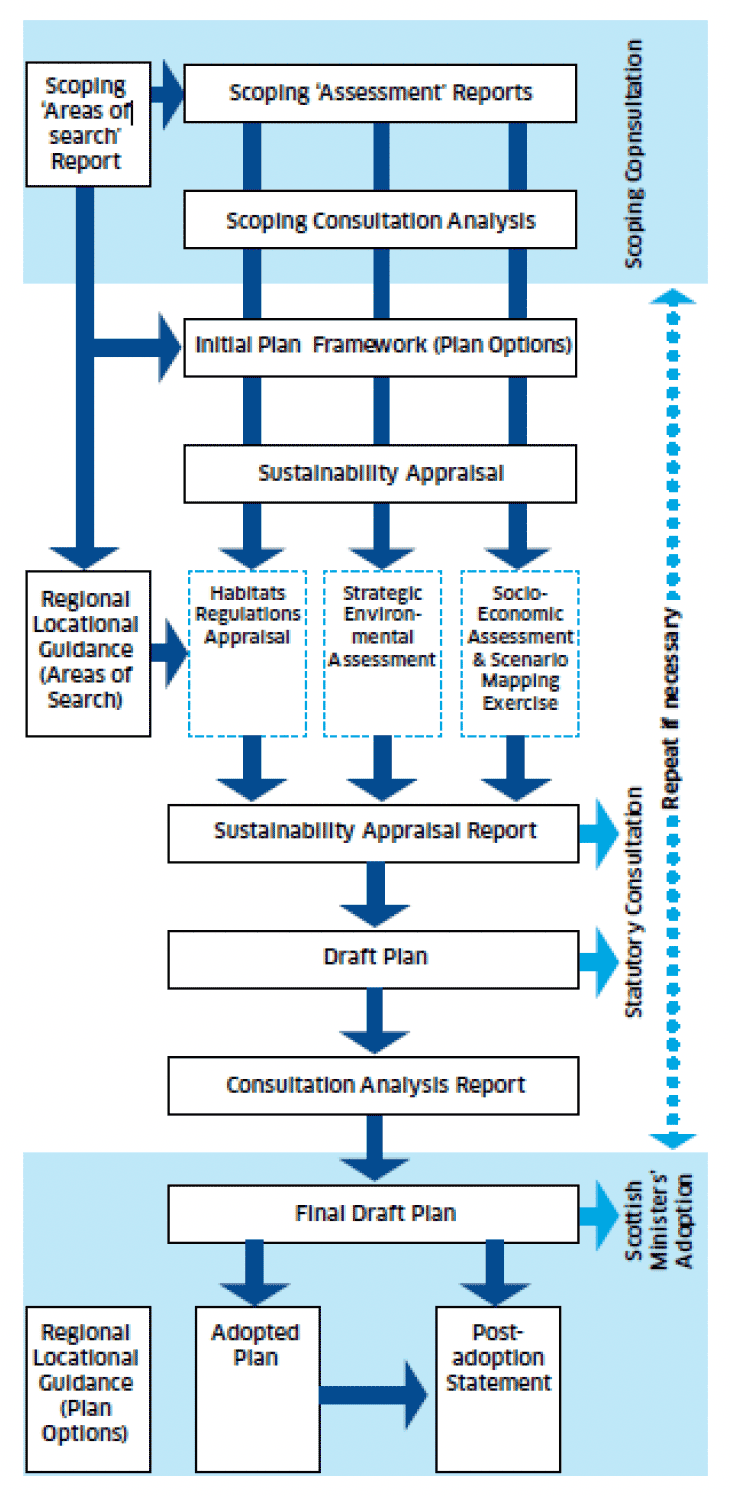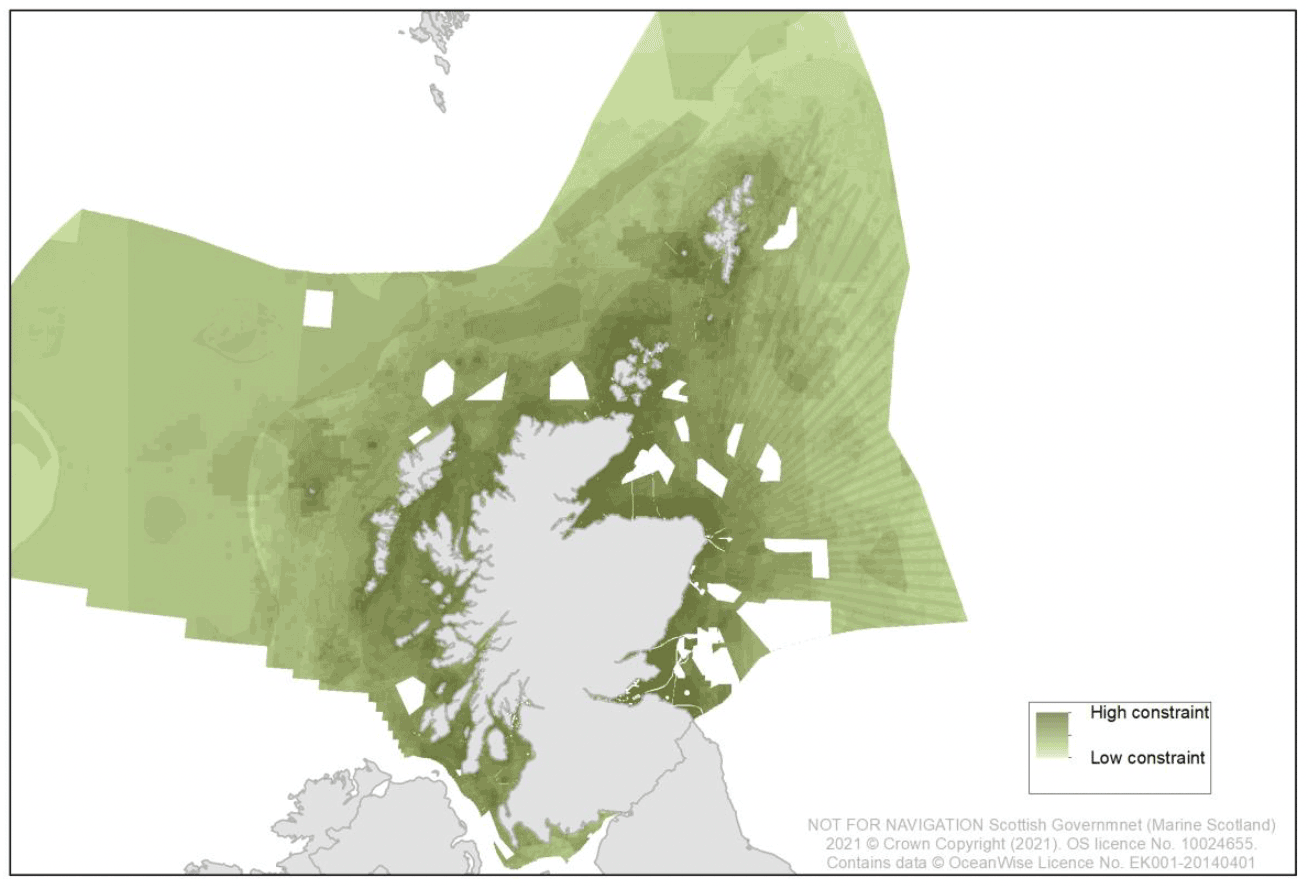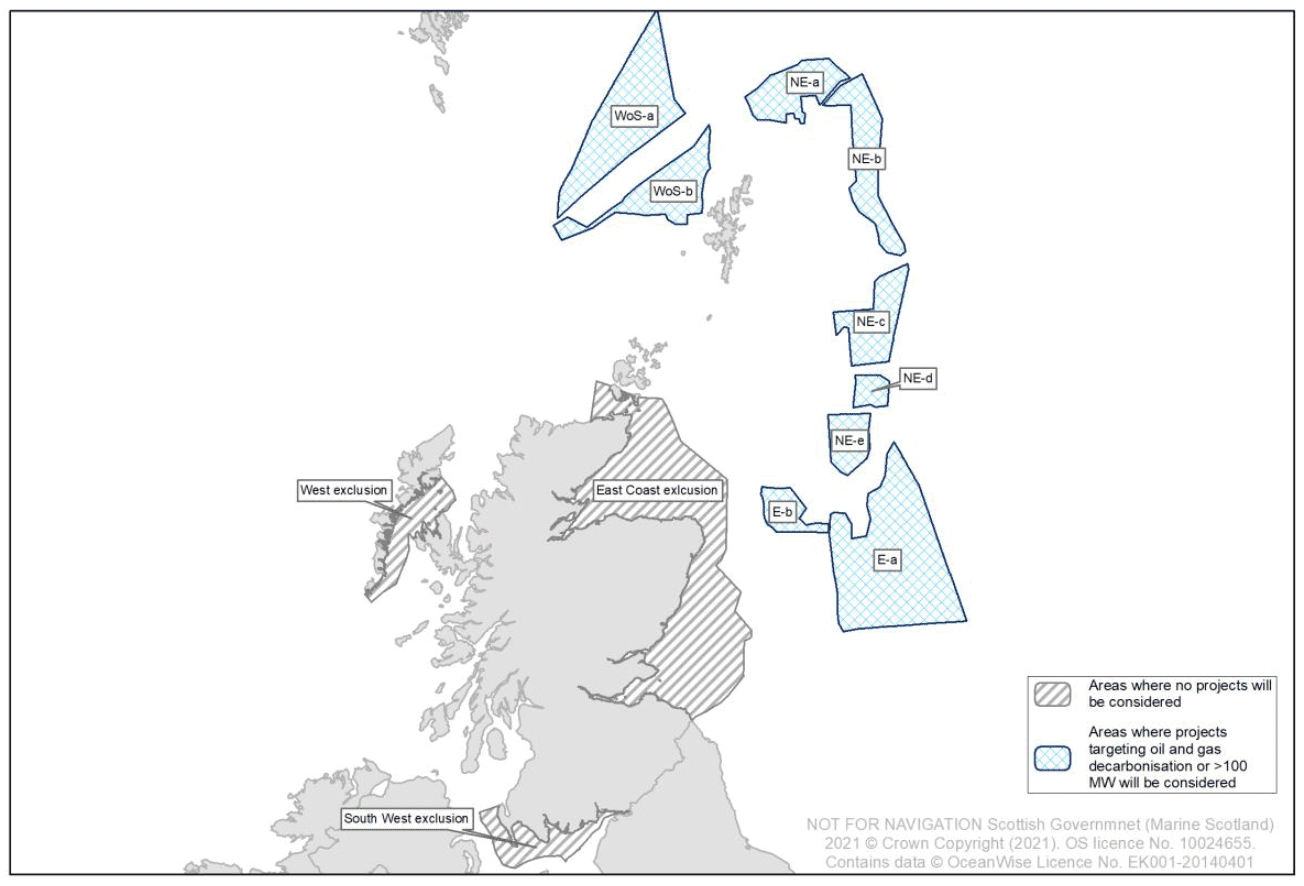Sectoral marine plan - offshore wind for innovation and targeted oil and gas decarbonisation: initial plan framework
The Initial Plan Framework (IPF) outlines the process for development of the Sectoral Marine Plan for Innovation and Targeted Oil and Gas (INTOG) Decarbonisation. The IPF also sets out the areas that will be used for future seabed leasing.
2 Plan Development Process
2.1 The following section provides details of the process for developing the Plan. Figure 1 (below) provides a diagrammatic representation of the process.

2.2 The following sections provide an explanation of the stages completed thus far and the process for remaining steps.
Areas of Search
2.3 The first step in the process was to undertake an Opportunity and Constraint analysis, examining at a national scale potential areas of opportunity for future development in line with the Plan specification. In line with Scottish Government strategies and commitments, it also examines areas where constraints or multiple conflicts may present challenges to future development, including negative effects for other sea users or environmental receptors. The full process and list of data considered is outlined in the Plan Specification and Context Report.[5] This analysis identified initial broad areas of opportunity and these were outlined as a series of Areas of Search (where development could take place) and areas of Exclusions (where development under this planning process would not be considered).
2.4 Figure 2 and Figure 3 below depict the collated Opportunity and Constraint analysis and the resulting Areas of Search:


2.5 These Areas of Search and the Plan Specification and Context Report as a whole were made available for comment and consultation between 25 August 2021 and 20 October 2021. These Areas of Search form the initial examination of areas that could be used for INTOG project development. These areas are distinct and spatially separate to the Plan Options adopted by Scottish Government in the SMP-OWE. INTOG projects cannot be located inside the previous Plan Options.
Scoping Assessment Reports
2.6 Separate to the Areas of Search work, screening and scoping for the Sustainability Appraisal assessments will be completed ahead of the leasing phase. In addition to setting the scope of assessments, this will include setting out methodologies for the future assessments.
Initial Plan Framework
2.7 The IPF provides the results of the Areas of Search consultation and any refinements of the Areas of Search or the planning specification itself.
Draft Regional Locational Guidance
2.8 Draft Regional Locational Guidance (RLG) is prepared in relation to the Areas of Search and subsequent Draft Plan Options. The Guidance provides more detailed technical, environmental, planning and socio-economic information in relation to the Options identified. This forms part of the Draft Plan Consultation and will be updated to reflect the final adopted plan.
Sustainability Appraisal
2.9 In accordance with both Scottish and UK environmental assessment legislation and Scottish Government policy, the development of the SMP will be subject to sustainability appraisal. This will comprise:
- Sustainability Appraisal
- Strategic Environmental Assessment
- Social and Economic Assessment
- Habitats Regulations Appraisal
- Consultation Analysis
Strategic Environmental Assessment (SEA)
2.10 The SEA will play a prominent role in the development of the Plan by identifying key environmental receptors, effects and mitigation measures, and by providing an early indication of issues to be addressed at the project level.
2.11 SEA will be applied to test and comment on the Plan Options as they are developed from a strategic perspective. The SEA process will be applicable to strategic and regional level issues. It will not be used to pre-empt project-level environmental assessment. The SEA findings and associated opinions arising from the consultation process will lead to broad recommendations for the Plan as a whole. The findings from the SEA process will also, where appropriate, be used as a starting point for further, more detailed data collection and environmental assessment, either for strategic review at a regional level or for developer project-level assessment. The SEA process could lead to alterations of the Plan Options.
Habitats Regulations Appraisal (HRA)
2.12 The HRA will assess Draft Plan Options for significant effects on Natura 2000 sites. The HRA findings may lead to alterations of the Plan if it is concluded that a development may result in a significant effect on a Natura 2000 site and that appropriate mitigation measures cannot be determined. An outcome of the HRA may include the reduction of Plan Options.
Social and Economic Impact Assessment (SEIA)
2.13 The SEIA will assess the potential positive and negative impact of the Plan as whole, examining both the individual Plan Options and the wider impact across social and economic receptors. Distinct from a cost/benefit analysis, the SEIA will estimate impacts both in economic terms but also through analysis of less quantitative impacts. This provides an informed position from which decisions on the final Plan can be made.
2.14 A representative cross-sectoral advisory group made up of key stakeholders and statutory consultees will provide input to all components of the assessments making up the Sustainability Appraisal.
Sustainability Appraisal Report
2.15 The Sustainability Appraisal Report provides a condensed version of the assessment information and conclusions relating to the Plan Options and the Plan as a whole. It will form part of the Draft Plan consultation.
Draft Plan
2.16 The key findings from the HRA, SEA and SEIA will inform the development of the Draft Plan. The Draft Plan will set out the proposed Plan Options. In the case of the INTOG planning round, these will have been identified via applications to CES as specific project locations within the Areas of Search set out in this IPF document. The Draft Plan will have assessed these project locations and will detail the results of the assessments through the sustainability appraisal.
2.17 The Draft Plan will be subject to formal consultation with the public and stakeholders for a minimum period of 12 weeks.
Statutory Consultation
2.18 Under the Environmental Assessment (Scotland) Act 2005, there is a requirement to consult on the Draft Plan and the SEA Environmental Report. As the Sectoral Plan is subject to Sustainability Appraisal, the SEA Environmental Report will be subject to consultation as part of the wider Sustainability Appraisal Report. The Statutory Consultation Authorities for the SEA are NatureScot, the Scottish Environmental Protection Agency (SEPA), Historic Environment Scotland (HES) and Joint Nature Conservation Committee (JNCC).
2.19 Consultation is also a statutory requirement of an HRA. The Statutory Consultation Authority for HRA is NatureScot. The respective documentation for the HRA and SEA processes will detail the procedures for consultation.
2.20 The Sustainability Appraisal Report, including the SEA and Social and Economic Impact Assessment will also be subject to formal consultation with the public and stakeholders for a period of at least 12 weeks. Where appropriate, extensions will be granted if consultees highlight that they require more time to respond.
Consultation Analysis Report
2.21 Consultation Analysis aims to ensure that key issues and concerns of the sectors and communities can be taken into account throughout the process. A Consultation Analysis Report will be produced which will detail the consultation responses to the Draft Plan and Sustainability Appraisal Report. The responses will be analysed and summarised and if required, subject to further consultation to ensure an accurate representation of the pre and statutory consultation processes. The key findings outlined in the Consultation Analysis Report will inform the development of the Final Plan.
Repeat Stage if necessary
2.22 If significant alterations are made to the Draft Plan as a result of the key findings from statutory consultation, there may be a requirement to undertake further consultation on an amended Draft Plan. This is a requirement of the Environmental Assessment (Scotland) Act 2005.
Final Draft Plan
2.23 The key findings and recommendations arising from the HRA, SEA, SEIA and Consultation Analysis will inform the development of the Final Draft Plan. The Final Draft Plan will contain the recommended Plan Options to progress as an adopted INTOG Plan.
Scottish Ministers' Approval
2.24 The Final Draft Plan will be submitted to the Scottish Ministers, who will decide the details of the Final Plan and confirm they are content to adopt the Plan.
Adopted Sectoral Plan
2.25 The Final Plan will contain the adopted Plan Options for development. In the INTOG case, those locations that have Exclusivity Agreements with CES are expected to seek to transfer these to formal Option Agreements. Any project locations that were deemed unsuccessful, via the Plan assessments or following the consultation, will not progress to the adopted plan. The Exclusivity Agreement will be terminated by CES and will not be transferred to a CES Option Agreement.
Post-Adoption Statement
2.26 A Post-Adoption Statement is a requirement of the Environment Assessment (Scotland) Act 2005. The statement outlines the reasons for choosing the Plan as adopted and details how environmental considerations have been incorporated into the Adopted Plan. It provides a record of the consultation responses and the subsequent actions taken in the plan development process as a result.
2.27 The Post-Adoption Statement for the Sectoral Marine Plan for Offshore Wind for Innovation and Targeted Oil and Gas Decarbonisation (INTOG) will also detail how considerations of the findings from the HRA and SEIA have been taken into account in the development of the Plan.
Contact
There is a problem
Thanks for your feedback